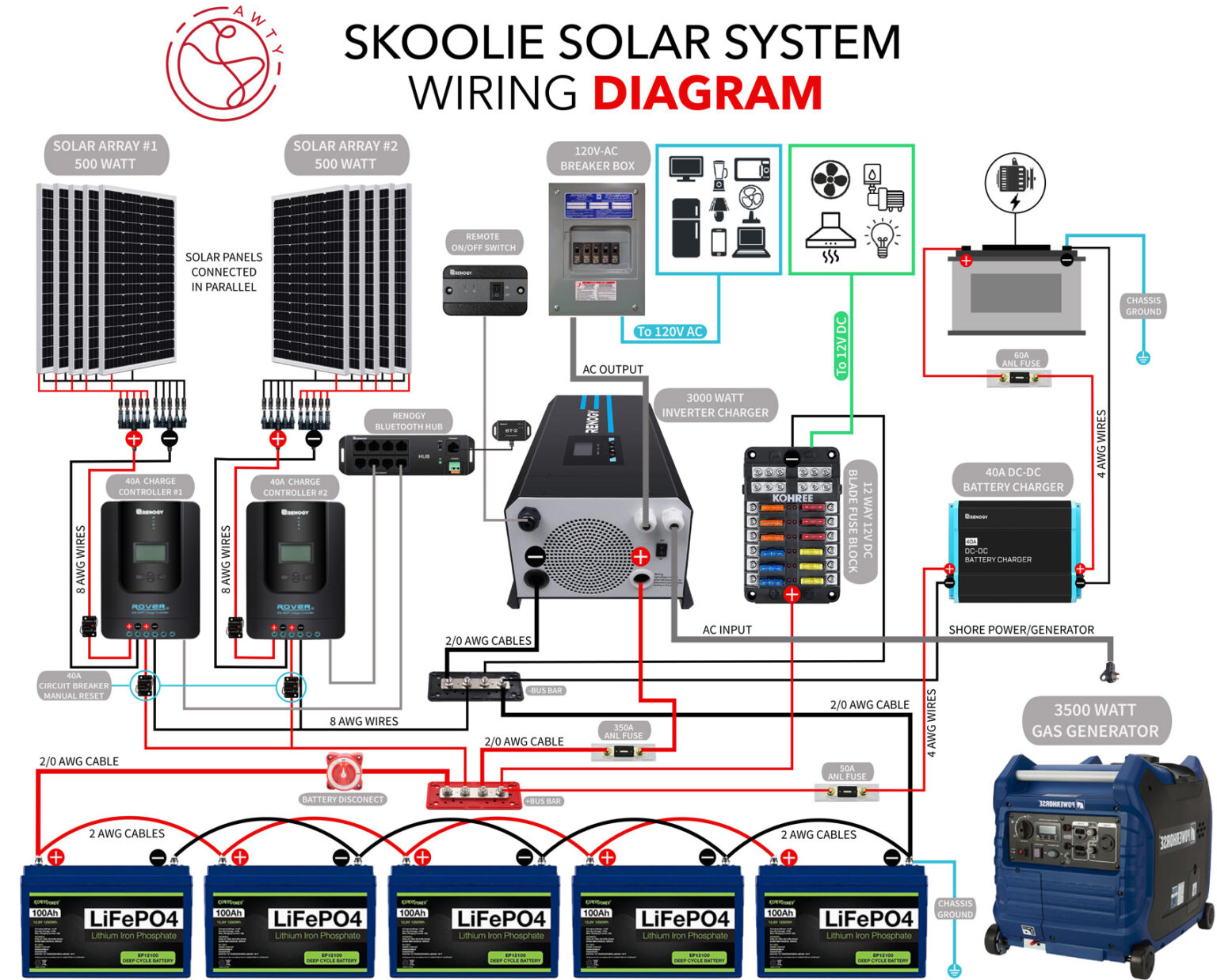How Do I Wire My Camper For Off-grid Solar Power?
“How do I wire my camper for off-grid solar power?”
However, wiring your camper for off-grid solar power can be a daunting task, especially for those without prior experience with electrical systems. In this article, we will provide a step-by-step guide on how to wire your camper for off-grid solar power, ensuring a safe and efficient installation.
Understanding Off-Grid Solar Power
Before we dive into the wiring process, it’s essential to understand the basics of off-grid solar power. Off-grid solar power systems use photovoltaic (PV) panels to generate electricity from sunlight, which is then stored in a battery bank for later use. The system consists of several components, including:
- Solar Panels: These are the panels that convert sunlight into electrical energy.
- Charge Controller: This device regulates the flow of energy from the solar panels to the battery bank, preventing overcharging.
- Battery Bank: This is where excess energy is stored for later use.
- Inverter/Charger: This device converts DC power from the battery bank to AC power, which is usable by your camper’s appliances.
- Distribution Panel: This is the main electrical panel that distributes power to your camper’s circuits.
Assessing Your Camper’s Electrical Requirements

Before designing your off-grid solar power system, it’s crucial to assess your camper’s electrical requirements. You’ll need to calculate your daily energy consumption in watt-hours (Wh). Consider the following:
- Appliances: List all appliances you plan to use, including lights, refrigerators, air conditioners, and TVs.
- Energy Consumption: Estimate the energy consumption of each appliance in watts (W) or watt-hours (Wh).
- Usage Patterns: Consider how often and for how long you’ll use each appliance.

A general rule of thumb is to assume:
- Lights: 10-20W each
- Refrigerator: 100-200W
- Air Conditioner: 1000-2000W
- TV: 50-100W
- Laptop: 50-100W

Designing Your Off-Grid Solar Power System
With your energy requirements in mind, you can design your off-grid solar power system. Here are some general guidelines:
- Solar Panel Size: Calculate the total wattage required to meet your daily energy needs. A general rule of thumb is to oversize your solar panel array by 20-30% to account for inefficiencies and cloudy days.
- Battery Bank Size: Calculate the total amp-hour (Ah) capacity required to store excess energy. A general rule of thumb is to size your battery bank to provide 2-3 days of autonomy.
- Inverter/Charger Size: Choose an inverter/charger that can handle the total wattage of your appliances and provide a sufficient charging capacity for your battery bank.
Wiring Your Camper for Off-Grid Solar Power
Now that you’ve designed your off-grid solar power system, it’s time to start wiring your camper. Here’s a step-by-step guide:
- Install Solar Panels: Mount your solar panels on the roof of your camper, ensuring they’re securely fastened and angled for optimal energy production.
- Install Charge Controller: Connect the solar panels to the charge controller, following the manufacturer’s instructions.
- Install Battery Bank: Connect the charge controller to the battery bank, ensuring the batteries are properly sized and configured for your system.
- Install Inverter/Charger: Connect the battery bank to the inverter/charger, following the manufacturer’s instructions.
- Install Distribution Panel: Connect the inverter/charger to the distribution panel, which will distribute power to your camper’s circuits.
- Wiring: Run wires from the distribution panel to each appliance, ensuring they’re properly sized and insulated.
- Grounding: Ensure your system is properly grounded, following the manufacturer’s instructions and local electrical codes.
Safety Precautions
When wiring your camper for off-grid solar power, safety should be your top priority. Here are some essential safety precautions:
- Use Proper Materials: Use only high-quality, UL-listed materials, including wires, connectors, and circuit breakers.
- Follow Manufacturer Instructions: Follow the manufacturer’s instructions for each component, including solar panels, charge controllers, and inverters/chargers.
- Hire a Professional: If you’re unsure about any aspect of the installation, consider hiring a professional electrician or solar installer.
- Regular Maintenance: Regularly inspect and maintain your off-grid solar power system to ensure it’s functioning safely and efficiently.
Tips and Tricks
Here are some additional tips and tricks to help you get the most out of your off-grid solar power system:
- Monitor Your System: Use a monitoring system to track your energy production and consumption, ensuring you’re optimizing your system’s performance.
- Optimize Your Appliance Usage: Be mindful of your appliance usage, turning off lights and electronics when not in use to conserve energy.
- Consider Energy-Efficient Appliances: Upgrade to energy-efficient appliances, such as LED lights and power-saving refrigerators, to reduce your energy consumption.
- Expand Your System: Consider expanding your system to include additional solar panels, batteries, or a backup generator to increase your energy independence.
Conclusion
Wiring your camper for off-grid solar power requires careful planning, attention to detail, and a commitment to safety. By following the guidelines outlined in this article, you can create a reliable and efficient off-grid solar power system that will provide you with the freedom to boondock and enjoy the great outdoors. Remember to assess your energy requirements, design your system with care, and follow proper safety precautions to ensure a safe and enjoyable off-grid solar power experience.
